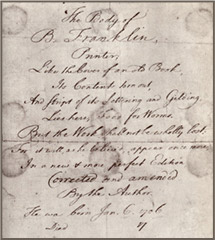|
t 81, Benjamin Franklin was twice the average age of the other members of the Constitutional Convention. Suffering from gout and kidney stones, he nevertheless continued his public career. In these final years of his life, Franklin remained open-minded and reflective. He renewed work on his autobiography—started years earlier—and served as President of the Pennsylvania Abolition Society, taking a prominent stand against slavery.
Since his death in April 1790, more than two centuries ago, Franklin has been memorialized, revered, romanticized, spoofed, and made into an advertising and financial icon. His face and figure have been depicted in every medium—stone, paint, film, cartoon, the Internet—and can be seen on billboards and building facades, postage stamps, and the $100 bill. Franklin’s name evokes imagination, wit, and entrepreneurial ingenuity worldwide. |
|
 |
|
Dr. Franklin’s Profile, 1982
|



